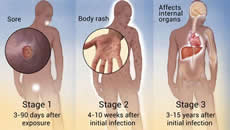Syphilis
 | Syphilis, is a bacterial infection usually spread by sexual contact that starts as a painless sore. Syphilis develops in stages and symptoms vary with each stage. |
What is it?
- It is caused by bacteria and can cause serious health problems if left untreated
- It is easy to cure if found early
- It is rarer in Australia but the numbers are increasing, especially in men who have sex with men and young Aboriginal and Torres Strait Islander people living in Northern Australia
Signs and Symptoms
Clinically the disease has 3 stages however about 50% of people will have no symptoms and will only be diagnosed by serological testing.
Primary Syphilis:
|
Secondary Syphilis:
|
Tertiary Syphilis:
|
Diagnosis
- Diagnosis is by a combination of serology, history and clinical assessment
- If serology is negative, repeat testing after 2 weeks if clinical suspicion of syphilis
Treatment
- Treated with antibiotics such as benzyl penicillin
- It is safest not to have sex, even with a condom, until after you have completed the full course of treatment as it is very infectious, particularly during the early stages
Recommended follow-up
- Advise no sexual contact for 7 days after treatment is administered
- Advise no sex with partners from the last 3 months (primary syphilis) and 6 months (secondary syphilis) until the partners have been treated if necessary
- Repeat testing at 3 months, then at 6 months and if necessary at 12 months after completing treatment
- Consider testing for other STIs at three-month visit, if not undertaken at first presentation or retesting post window period
Contact tracing
- Primary syphilis: 3 months plus duration of symptoms
- Secondary syphilis: 6 months plus duration of symptoms
- Late latent syphilis: long term partners only
- Partners should be traced back for 6 months
- Contacting all sexual contacts during potential time of infection
For more information
- Health Direct - Syphilis
- Australian STI Management Guidelines - Syphilis
- Contact Tracing: You can now contact trace via SMS, email or send a letter to “Let Them Know” anonymously.